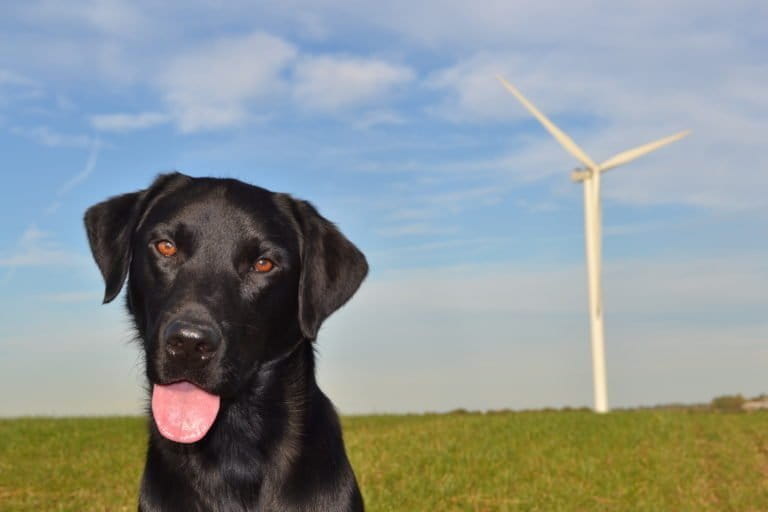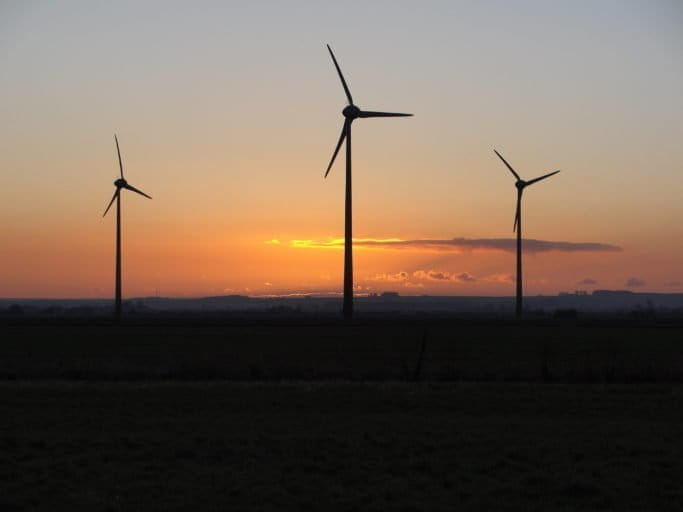- A study of 46 wind farms in the UK found that preliminary environmental impact assessments aren’t good predictors to determine which sites pose the most danger to bats.
- Several of the sites expected to have little or no bat activity ended up having the most, according to surveys of bat activity and casualties.
- Scientists still struggle to understand why wind farms pose such a substantial threat to bats. One hypothesis is that bats mistake the tall towers and turbines for trees.
Bats have seemingly always had a troubled relationship with wind farms. Giant whirling turbines scuttle their sensitive hearing and sonar, bringing down huge numbers in a way that only a Chiropteran plague such as white-nose syndrome can match.
Laws to protect bats mean that companies and researchers often put a lot of time and energy into ecological studies on the likely impacts on bats before towers and turbines are erected at specific sites. But new research published today in the journal Current Biology demonstrates that that investment hasn’t translated into safer flyways.
“These things don’t seem very well able to predict what happens in the future,” said Fiona Mathews, a biologist at the University of Exeter in England and an author of the study.

Recently, Mathews and her colleagues had been asked to put some numbers to the impacts that wind farms around the UK have on bats. To do this, teams of dogs and handlers searched for carcasses on the ground around the bases of six randomly selected turbines at 46 wind farms in the UK. The researchers also made overnight recordings with ultrasonic microphones to listen in on the bat activity happening overhead.
With that data in hand, Mathews realized that they had a chance to see if the numbers of fatalities and relative bat activity were in line with the initial assessments, done before the wind farms were constructed.
For the most part, the assessments weren’t very accurate. Mathews and her colleagues found dead bats at half of the sites where little impact had been expected. The four wind farms with the highest bat activity also fell into that category.
“I think we like to think that we’ve got everything sorted and we know how animals are going to respond,” Mathews said. “The reality is that ecology is quite complicated.
“We’re dealing with living animals that can respond in ways that we haven’t necessarily predicted ahead of time,” she added.
Paul Cryan, a biologist with the United States Geological Survey in Fort Collins, Colorado, agreed.
“From a risk-prediction perspective, the risk may not occur or be measurable until the turbine is there to attract the bats,” said Cryan, who was not involved in the research. “We call this the ‘If you build it, will they come?’ question.”

Even as wind power technology has improved, the threats to some bat species have remained “consistent and widespread,” he said. But until now, no one has looked at whether the planning process makes a difference.
“This may be the first paper published and widely accessible to the scientific community that examines the efficacy of pre-construction impact assessments for bats at wind turbines,” Cryan said.
It has also revealed a need to follow up on these assessments after wind farms are in place, Mathews said. Right now, that’s rarely happening.
“It’s almost like if you had a patient in hospital. You might think, ‘OK, let’s get the diagnosis and then we’ll give them a bunch of drugs,’” she said. “But then we won’t see whether it’s actually making them better.”
As Mathews and Cryan point out, the biology of bats is puzzling. It might be that bats spot the tall towers and think they’re trees where they might find a meal or a place to rest or other bats. That’s a hunch some biologists have because most of the fallen bats in the US are species that like to hang out in trees, Cryan explained.
But whether that’s the case, or there’s some other reason that bats seem to be attracted to – and killed at – wind farms remain open questions for scientists, making preconstruction analyses difficult.

“It’s a tricky situation,” he said “People are tasked with assessing risk of wind turbines to bats, yet we do not know why these machines pose a risk to bats in the first place.”
Experts are finding, however, that we can minimize the risk to bats with what’s called “feathering,” or turning the blades away from the wind when bats are the most active during certain times of the year – often at night and in the summer.
Typically, it’s not very windy at those times, so many times the operator may have disconnected the turbines from the power grid anyway, Mathews said. That could translate into a “win-win scenario,” she added. The operator wouldn’t be sacrificing much energy-generating potential while saving bat lives in the process.
“What I’d say is that I think that most of these adverse effects that we’re seeing can be dealt with,” Mathews said. “I don’t think that they’re show stoppers.”
But, as this research shows, we might not be able to pinpoint these issues until after the turbines start spinning.
Citations:
- Lintott, P. R., Richardson, S. M., Hosken, D. J., Fensome, S. A. and Mathews, F. (2016). “Ecological impact assessments fail to reduce risk of bat casualties at wind farms.” Current Biology.
- O’Shea, T. J., Cryan, P. M., Hayman, D. T. S., Plowright, R. K. and Streicker, D. G. (2016). Multiple mortality events in bats: a global review. Mammal Review.
Banner image courtesy of Fiona Mathews
